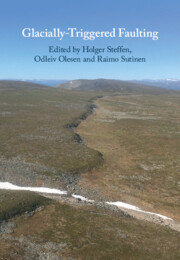Book contents
- Glacially-Triggered Faulting
- Glacially-Triggered Faulting
- Copyright page
- Contents
- Figures
- Tables
- Contributors
- Preface
- Part I Introduction
- Part II Methods and Techniques for Fault Identification and Dating
- Part III Glacially Triggered Faulting in the Fennoscandian Shield
- 10 Seismicity and Sources of Stress in Fennoscandia
- 11 Postglacial Faulting in Norway
- 12 Glacially Induced Faults in Sweden
- 13 Glacially Induced Faults in Finland
- 14 Lateglacial and Postglacial Faulting in the Russian Part of the Fennoscandian Shield
- Part IV Glacially Triggered Faulting at the Edge and in the Periphery of the Fennoscandian Shield
- Part V Glacially Triggered Faulting Outside Europe
- Part VI Modelling of Glacially Induced Faults and Stress
- Part VII Outlook
- Index
- References
14 - Lateglacial and Postglacial Faulting in the Russian Part of the Fennoscandian Shield
from Part III - Glacially Triggered Faulting in the Fennoscandian Shield
Published online by Cambridge University Press: 02 December 2021
- Glacially-Triggered Faulting
- Glacially-Triggered Faulting
- Copyright page
- Contents
- Figures
- Tables
- Contributors
- Preface
- Part I Introduction
- Part II Methods and Techniques for Fault Identification and Dating
- Part III Glacially Triggered Faulting in the Fennoscandian Shield
- 10 Seismicity and Sources of Stress in Fennoscandia
- 11 Postglacial Faulting in Norway
- 12 Glacially Induced Faults in Sweden
- 13 Glacially Induced Faults in Finland
- 14 Lateglacial and Postglacial Faulting in the Russian Part of the Fennoscandian Shield
- Part IV Glacially Triggered Faulting at the Edge and in the Periphery of the Fennoscandian Shield
- Part V Glacially Triggered Faulting Outside Europe
- Part VI Modelling of Glacially Induced Faults and Stress
- Part VII Outlook
- Index
- References
Summary
This chapter reviews the results of studies of late- and postglacial faults in the Russian part of the Fennoscandian Shield (Kola Peninsula, Karelia, Sankt-Petersburg region). It provides a brief overview and description from north to south of the main seismic lineaments (Murmansk and Kandalaksha) as well as results from a study of some secondary lineaments, individual late- and postglacial faults and seismic dislocations. The obtained data allowed defining a decrease in seismic activity from the Late Glaciation to the present times. It is due to the fading glacial isostatic uplift of the shield and the change of the leading role from the vertically directed forces of glacial isostasy to horizontal compressive strains. Glacial isostasy as a factor giving rise to stresses has nearly exhausted itself by the present time, while the tectonic factor continues to be felt.
Keywords
- Type
- Chapter
- Information
- Glacially-Triggered Faulting , pp. 246 - 260Publisher: Cambridge University PressPrint publication year: 2021
References
- 2
- Cited by



